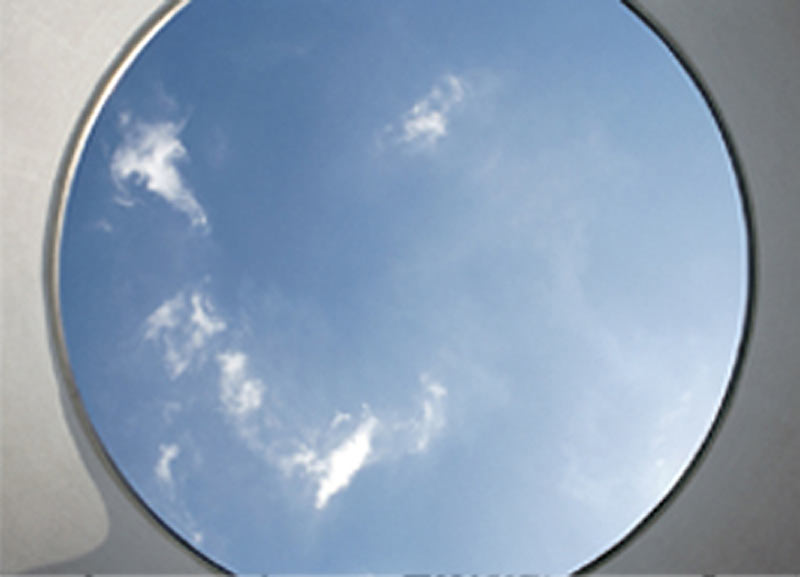The Big View
By Max Levy Texas Architect Magazine November 1996
 Architecture is uniquely equipped to bring this consciousness into our daily comings and goings One of architecture’s most elementary acts is the framing of a view. Placing a frame around something in the right way emphasizes it, takes it out of context for a moment, and thereby releases our perceptions to enjoy a heightened vision. The great Bay Area architect, William Wurster said, “Architecture is the picture frame and not the picture.” In this respect there are great, untapped, creative opportunities to bring the sky into play architecturally. Using building planes, openings, or other architectural strategies a piece of sky can be set apart. If the upward view you have captured is free of telephone poles, tree limbs, and other buildings, you will see a picture as intense and refreshing as a window onto the Mediterranean. Sometimes you will have to wait awhile for the view you want: The “ocean” overhead has its periods of dull calm, flat and gray. But it is alive and therefore constantly changing, a vast untamed wildness in the very midst of our cities.
Perhaps more than any other architect, Luis Barragan of Mexico knew how to capture this blue wildness. In his urban and suburban buildings he employed courtyards in a new way. Traditionally, courtyards are the domain of the intimate, inner view. But Barragans courtyards are empty, formed by detail-less wall planes saturated with color, terminating crisply against the sky. The sky completes the courtyard composition and becomes the living part of the picture. These silent, contemplative spaces compel one's gaze upwards.
My office recently completed a house oriented in this direction. Its flat roof is punctuated by a series of forms that offer each principal room the culmination of a carefully framed sky view. From inside this building these commonplace vistas seem luminous and startlingly pure. Under their influence, it is difficult to move from room to room without being awakened from the trance of ones routine.
Architecture is uniquely equipped to bring this consciousness into our daily comings and goings One of architecture’s most elementary acts is the framing of a view. Placing a frame around something in the right way emphasizes it, takes it out of context for a moment, and thereby releases our perceptions to enjoy a heightened vision. The great Bay Area architect, William Wurster said, “Architecture is the picture frame and not the picture.” In this respect there are great, untapped, creative opportunities to bring the sky into play architecturally. Using building planes, openings, or other architectural strategies a piece of sky can be set apart. If the upward view you have captured is free of telephone poles, tree limbs, and other buildings, you will see a picture as intense and refreshing as a window onto the Mediterranean. Sometimes you will have to wait awhile for the view you want: The “ocean” overhead has its periods of dull calm, flat and gray. But it is alive and therefore constantly changing, a vast untamed wildness in the very midst of our cities.
Perhaps more than any other architect, Luis Barragan of Mexico knew how to capture this blue wildness. In his urban and suburban buildings he employed courtyards in a new way. Traditionally, courtyards are the domain of the intimate, inner view. But Barragans courtyards are empty, formed by detail-less wall planes saturated with color, terminating crisply against the sky. The sky completes the courtyard composition and becomes the living part of the picture. These silent, contemplative spaces compel one's gaze upwards.
My office recently completed a house oriented in this direction. Its flat roof is punctuated by a series of forms that offer each principal room the culmination of a carefully framed sky view. From inside this building these commonplace vistas seem luminous and startlingly pure. Under their influence, it is difficult to move from room to room without being awakened from the trance of ones routine.
 Increasingly amidst the visual litter of our cities and suburbs, the only unfettered view we have left is upward. Compared to our mishandling of the land, the sky remains little changed since Coronado trekked around Texas almost 500 years ago. Although it is probably not as blue as it once was, Coronados sky endures to this day, floating above our complications.
Here at the end of the 20th century as the computer lures us into an endless stream of inner views, we need the relief of the big outer view more than ever before.
Increasingly amidst the visual litter of our cities and suburbs, the only unfettered view we have left is upward. Compared to our mishandling of the land, the sky remains little changed since Coronado trekked around Texas almost 500 years ago. Although it is probably not as blue as it once was, Coronados sky endures to this day, floating above our complications.
Here at the end of the 20th century as the computer lures us into an endless stream of inner views, we need the relief of the big outer view more than ever before.
